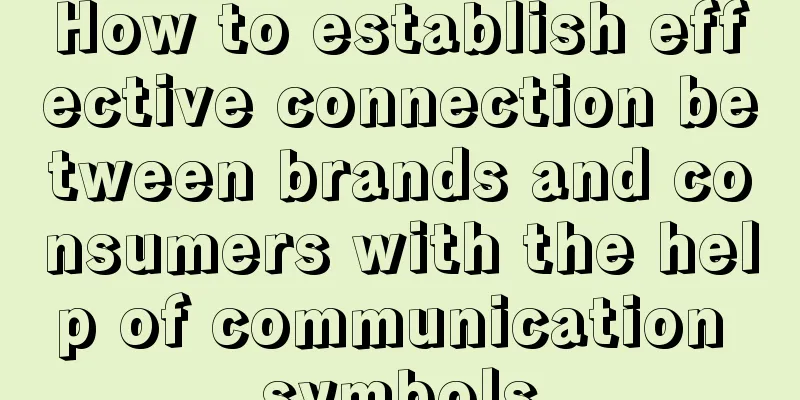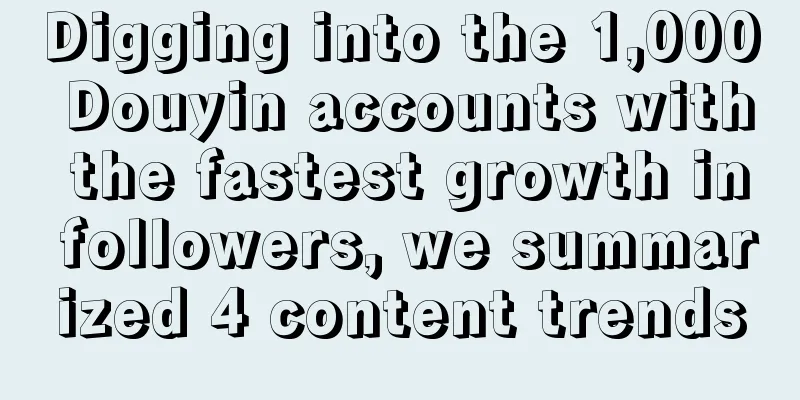How to establish effective connection between brands and consumers with the help of communication symbols

The core of marketing lies in establishing an effective connection between brands and consumers. This can be achieved through a series of strategic steps, including making strangers aware of the brand, deepening the recognition of weak ties, strengthening the recognition of strong ties, and gaining high recognition from loyal fans. In this process, marketers need to pay attention to communication symbols, consumption reasons, repurchase word-of-mouth and emotional connections in order to adopt effective strategies and measures. Today, we will focus on communication symbols. 1. So, what are communication symbols?Communication symbols refer to brand elements in mass communication that have group memory capabilities and unique information value. They are an important tool for brands to communicate with consumers, and they can help brands leave a deep impression in the minds of the public. These symbols can be words, images, sounds, gestures or any other forms of expression, and even in a broader sense can include various forms of language and non-language, which are used to convey specific meanings or information. For example:
In the field of marketing, communication symbols are particularly important because they are used to create a brand image, attract the attention of the target audience, stimulate emotional responses, and motivate consumers to take action. 2. The underlying logic of communication symbolsThe reason why communication symbols can play such an important role is that there are some underlying logics behind them. In this era of information explosion, the communication between brands and consumers has become increasingly complex. In order to stand out from the crowd, it is crucial to understand the underlying logic of communication symbols and use them well. 01 Unique Selling PointThe unique selling point is the most important basic logic of communication symbols. Brands often emphasize the unique characteristics of their products so that consumers can form a comparison in their minds and remember them. What this means is that we should not only emphasize our own uniqueness, but also pay attention to the fact that this uniqueness must be linked to consumer demand, so that consumer cognition can be mobilized and involved in comparative evaluation with other products or brands. For example, when Yunnan Baiyao launched its Band-Aid product, it put forward the slogan "Heal faster with medicine", which concisely and clearly conveyed a message: using Yunnan Baiyao's products can accelerate the wound healing process. This slogan not only highlights the uniqueness of the product, but also directly links to the needs of consumers - the desire to quickly restore health. With this unique selling point, Yunnan Baiyao successfully distinguishes its products from other similar products on the market and leaves a deep impression on consumers. 02 No.1 in CategoryThe logic behind this is to highlight the industry status and gain recognition and trust from consumers by claiming that the brand is the first in a certain category. For example, Bosideng successfully took a leading position in the market by launching a new product category of windbreaker down jackets and emphasizing that it was the "first to create windbreaker down jackets." Through clear market positioning, support based on market data and multi-channel communication strategies, Bosideng has not only strengthened its image as a category pioneer, but also further enhanced its brand value and market position. It has not only demonstrated Bosideng's innovation ability and leadership in the down jacket field, but also effectively enhanced consumers' recognition and trust in its brand. When is the first in a category used? When a brand does take the lead in a certain category, it can use this statement to enhance the brand's market position and consumer trust. At the same time, it should be noted that in order to ensure that this information is widely known by consumers, the brand also needs to support this statement through appropriate marketing and advertising. 03 Scenario-drivenScenario-driven marketing uses common scenarios in daily life to trigger consumers’ resonance. We have all heard of the advertising slogan, “Drink Red Bull when you are tired.” Being tired and sleepy is obviously a common situation in our daily life. It is universal. Being tired and sleepy is a kind of need, which belongs to the basic needs of the masses. Slogans such as "Drink Red Bull when you are tired and sleepy" accurately capture the fatigue that consumers may encounter at work or study. By creating a specific scenario, Red Bull successfully positions itself as a solution to the problem of fatigue. For potential customers, memory is strong and the awakening rate is high, so the effect of selling products around this scenario will naturally not be bad. 04 Call to ActionA call to action is a clear appeal to consumers to take some action. For example, Zhihu’s former slogan: “If you have any questions, go to Zhihu.” is a typical call to action. This concise and powerful call to action encourages users to seek answers when they encounter problems, and to find answers on the Zhihu platform. This direct appeal not only increases the platform's traffic, but also strengthens Zhihu's image as a knowledge sharing community. Many people feel that calls to action and scene-driven are somewhat similar. What is the difference between them? Scenario-driven is to create or evoke consumers' feelings or needs in specific situations, thereby guiding them to naturally think of a certain brand or product. The call to action is more direct, and it explicitly calls on consumers to take some action. This call is usually accompanied by clear instructions, such as "If you have any questions, go to Zhihu", "Buy it!", etc. Scenario-driven advertising usually does not require a large amount of advertising investment to be effective because it relies on situations that consumers naturally encounter in real life; calls to action often require advertising or other forms of promotion to increase their visibility and influence, and their effects may weaken once advertising stops. 05 AnalogyAnalogy is the process of associating a brand with more famous or influential brands, things, or images, leveraging the momentum to increase its own recognition. For example, Qinghualang’s advertisements have long claimed to be “one of the two major sauce-flavored liquors in China” and “one of the two major sauce-flavored liquors along the Chishui River”, using analogy logic to enhance its brand image. Qinghualang's analogy strategy is based on consumers' existing common sense that Moutai is one of the most famous liquors in China, and they also know the connection between Moutai and the Chishui River. Therefore, when Qinghualang calls itself "one of the two major sauce-flavor liquors on the Chishui River", it implies that it is the second best sauce-flavor liquor in China by comparing itself with Moutai. This strategy enables Qinghualang to occupy a higher position in the minds of consumers. 06 AnalogyWhen it is difficult to explain things or concepts clearly in one dimension, analogies are used to help consumers quickly understand the characteristics or value of a product by using easy-to-understand metaphors. For example, Bananain’s flagship product “My Basics” is an analogy that puts some originally unrelated products (home clothes that can be worn outside, mosquito-proof pants, label-free underwear, etc.) under the same category and gives it a business concept called “My Basics”. 07 ChallengeUsually, the brand is small and has insufficient marketing resources. By comparing with competitors, the brand can highlight its own advantages. In fact, the brand is also a kind of leverage, a tit-for-tat comparison. We see that the person who uses this strategy the most is Luo Yonghao, especially during the early days of the Hammer mobile phone startup. Not only did he compare himself to the Chinese Steve Jobs, he also challenged Apple, believing that the Hammer mobile phone had a better design. "Challenging" may easily win attention and traffic, but it also puts the brand and product under the spotlight and puts them through more rigorous tests, so "challenging" must be done with "confidence", otherwise it will backfire. In this regard, the Hammer phone is also a typical case. 08 MemoryMemory logic is to use repeated slogans, visual elements or content to deepen consumers' memory. Well-known brands such as Hengyuanxiang, Melatonin, and Earl Travel Photography all follow this route. For example, Yuanqi Forest has created the content memory point of "0 sugar, 0 fat, 0 calorie sparkling water", which differentiates itself from competitors and creates a differentiated positioning that allows the audience to remember and induces them to try consumption. 09 Value PropositionThe so-called value proposition is to convey the brand's core ideas and values through a strong value proposition, and seek people's recognition and resonance. Take the Apple brand as an example. Its value proposition is Think different, which means “different” in plain language. This is the slogan proposed by Steve Jobs in an internal speech after he returned to Apple in 1997. However, this is no longer just a slogan, but also a reflection of Apple's brand philosophy and social values. It conveys an innovative spirit, encouraging people to break the rules and pursue uniqueness. This value proposition not only reflects the characteristics of Apple's products, but also fits with consumers' pursuit of personalization and innovation. “Think different”, as Apple’s communication symbol, transcends ordinary brands, products, and companies and becomes a value proposition that rises to the level of philosophy and social values. As a result, it has won the support and love of a large number of fans, and some people even jokingly call its fan group "Apple worshipers." 10 Implicit ClaimsImplicit claims refer to the values or information that a company or brand conveys to consumers through indirect means such as product design, user experience, marketing materials, etc. This kind of claim is often not expressed through direct slogans or clear text descriptions, but allows consumers to feel it naturally in the process of using the product. For example, Patagonia demonstrates its commitment to environmental protection and social responsibility through its choice of eco-friendly materials and its encouragement of customers to repair old clothes, which is an implicit claim. In addition, Patagonia further emphasizes its emphasis on fair trade and sustainable development by disclosing its supply chain information, which is also part of its implicit claim. These practices are not just business strategies; they more deeply convey Patagonia’s core values as a company. It has not launched large-scale marketing campaigns, but has maintained good sales performance and market share in the trend. 11 LifestyleBrands can attract consumers who pursue a lifestyle by conveying the concept of a lifestyle. MUJI conveys a simple, natural, and practical lifestyle through its minimalist design, use of natural materials, emphasis on practicality and functionality, and affordable luxury products and services. This philosophy attracts consumers who identify with the philosophy of minimalist living and hope to have a more relaxed and comfortable life experience by reducing material burdens. MUJI successfully shares the values of this lifestyle with consumers and strengthens its connection with consumers by continuously launching new products that meet this philosophy. 12 Causal AppealClearly demonstrate the cause-and-effect relationship between product features and consumer benefits, and how consumer needs are met. For example, OPPO's popular product R9 was inseparable from the slogan "Charge for 5 minutes, talk for 2 hours." It not only highlights the selling point of OPPO mobile phones that can be quickly charged in 5 minutes, but more importantly, it intuitively conveys the benefits that technological advantages bring to consumers - 2 hours of talk time, thereby enhancing the product's attractiveness and giving consumers a strong reason to buy. 13 Emotional LinkCreate meaningful content or experiences through content or media to make consumers resonate with the brand on an emotional level and establish an emotional connection between the brand and consumers. Nike often releases motivational video ads, such as the "Just Do It" series, which not only show the athletes' wonderful moments, but also tell the stories behind them, inspiring the audience to pursue their personal best. For example, during the 2020 epidemic, Nike launched the "Play Inside, Play for the World" campaign to encourage people to exercise at home and stay healthy and positive. 3. How to create communication symbolsSo, how should we design effective communication symbols? Many people think that giving a product or a brand a particularly loud slogan is called a communication symbol, and adding enough advertising money to promote it, the communication symbol is successfully created and can drive the rise of the brand. This view can be said to be a big mistake. It simplifies the design of communication symbols and misunderstands their communication effect.' As for how to design effective communication symbols, it is recommended that you think, plan and promote according to the following steps. Step 1: Focus on customer needs and create popular productsDeeply understand the market segments: In a highly competitive market environment, brands should first identify the segments of their target audience and gain a deep understanding of their needs, preferences and pain points. By focusing on specific circles or scenarios, brands can more accurately position their products to meet the unique needs of that group. Developing big single products in the circle: Based on in-depth understanding, brands should develop "big single products in the circle" with differentiated competitive advantages. These products should not only solve the pain points of target customers, but also have high cost performance to stand out in the market segment. By continuously optimizing the product experience, brands can gradually establish a leading position in this circle. Step 2: Build brand memory points and deepen customer awarenessCreate unique cognitive symbols: Brands should design a series of communication symbols that are recognizable and memorable, including brand logos, slogans, visual elements, etc. These symbols should be concise, easy to identify and remember, and closely linked to the core values and concepts of the brand. Through continuous and unified communication, the brand can leave a deep impression in the minds of customers. Strengthen emotional experience: In addition to visual and auditory symbols, brands should also focus on emotional connections. By telling brand stories and conveying brand values, brands can inspire customers' emotional resonance and enhance their identification and loyalty to the brand. This emotional connection helps brands establish a more solid position in customers' minds. Step 3: Implement category-based marketing to guide customer decision-makingClear category positioning: Brands should clarify their positioning in the category based on market segmentation and customer needs. Through clear category positioning, brands can more accurately convey the unique selling points of their products and reduce customers' decision-making costs. Guiding purchase decisions: In the process of category marketing, brands should guide customers to make purchase decisions through various channels and methods. This includes clearly displaying product advantages in advertisements, providing convenient purchase channels, and carrying out promotional activities. At the same time, brands should also pay attention to customers' purchase experience and feedback, and continuously optimize products and services to improve customer satisfaction and loyalty. Take advantage of traffic and content dividends: In the digital age, brands should make full use of channels such as social media and content marketing to expand brand exposure and influence. By creating high-quality content and cooperating with KOLs, brands can attract more potential customers and guide them to convert into actual buyers. IV. ConclusionA good communication symbol should combine the circle of big single products on the customer demand side, the group memory points on the customer cognition side, and the category marketing on the customer decision-making side. Such a communication symbol starts with an excellent product foundation, grows through carefully designed cognitive management, and helps the brand stand out in the fiercely competitive market. |
>>: "Information flow" is not a panacea, click-through rate is the key to success or failure
Recommend
Are there any requirements for Amazon brand sellers? What are the characteristics?
On Amazon, if you want to open a store, you usuall...
Brand No. 1: Vacancy Competition Series 013
In the fierce market competition, how brands find ...
Leveraging marketing is so important! But you don’t know how to follow the hot spots? [Overseas Hot Spots Operation Guide]
Hot spots are indispensable for marketing. So how ...
The reputation of “giving gifts” started off strong but ended up declining. Will it become a “holiday limited” feature of WeChat?
Since the grayscale test of WeChat's "Sen...
Can Shopee Feed smart fans see it? What is it for?
Shopee Feed is a new social space created for sell...
The most difficult 618 in history, who makes money by selling goods on B station
The cost of acquiring traffic on e-commerce platfo...
How to adjust the Amazon advertising budget if it is exceeded? How to solve it?
Many friends on Amazon will do promotion. After al...
Freemium vs Free Trail: Which one has better business growth?
When deciding on a product's business model, w...
From automatic price tracking to AI price negotiation, e-commerce low-price wars surround merchants
New shopping trends such as "refund only"...
Milk tea prices drop across the board! Starting from 4 yuan per cup, "hard competition" with Mixue Bingcheng
Competition in the new tea beverage market is beco...
With Sora's brutal intrusion, how can advertising professionals survive?
OpenAI released the Vincent video model Sora. What...
What are the top ten regular overseas purchasing apps?
Many consumers want to buy overseas products. If t...
Looking at the Customer Selection of Large Models from the Perspective of Communication
The full article deeply analyzes the difficulties ...
Taotian's "interconnection" business philosophy: 150 million new users, 2 trillion incremental GMV
In the prelude to Double 11, Taobao and Tmall open...
What are the cross-border third-party payment platform models? What are their characteristics?
On cross-border e-commerce platforms, after mercha...









